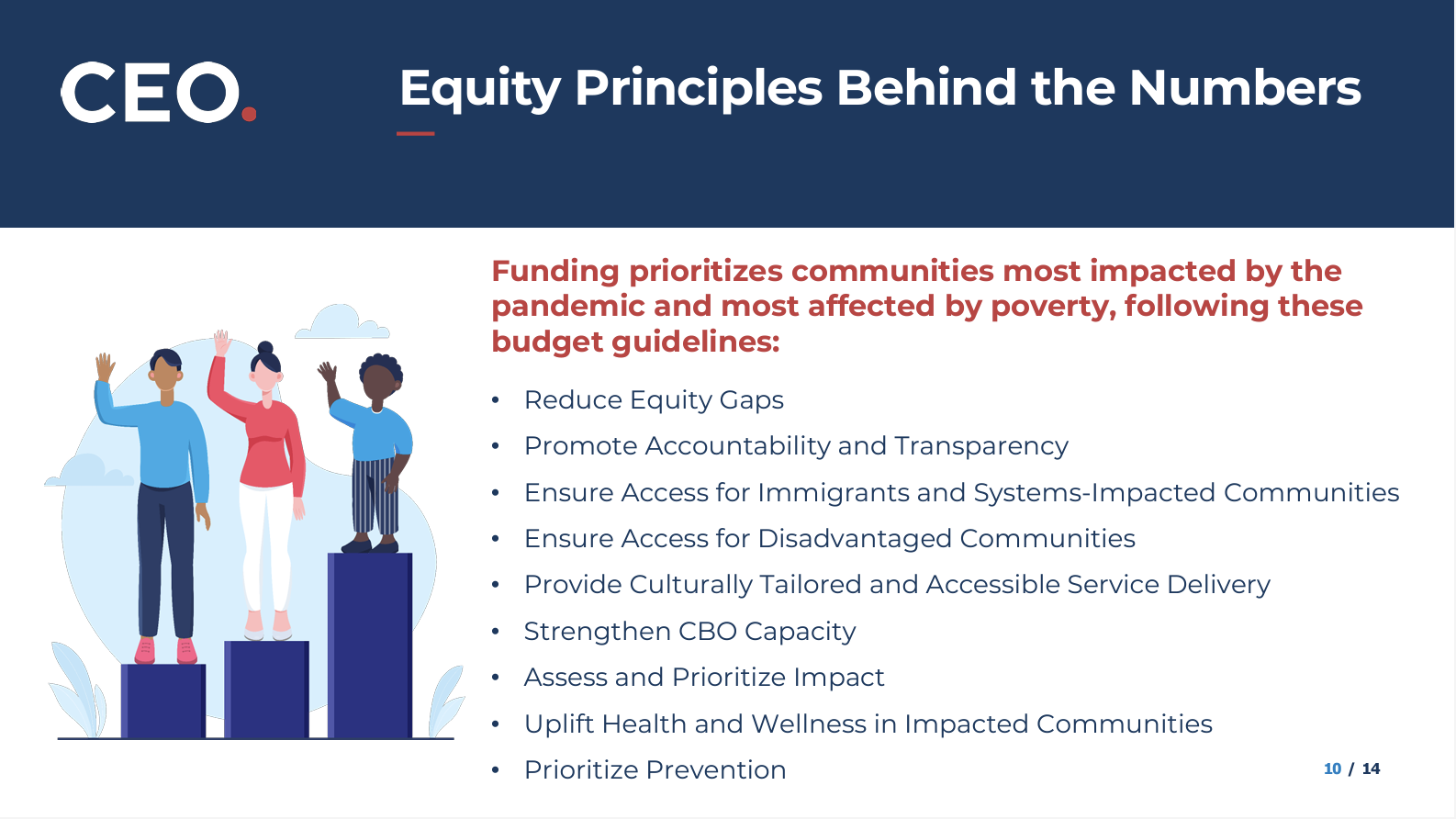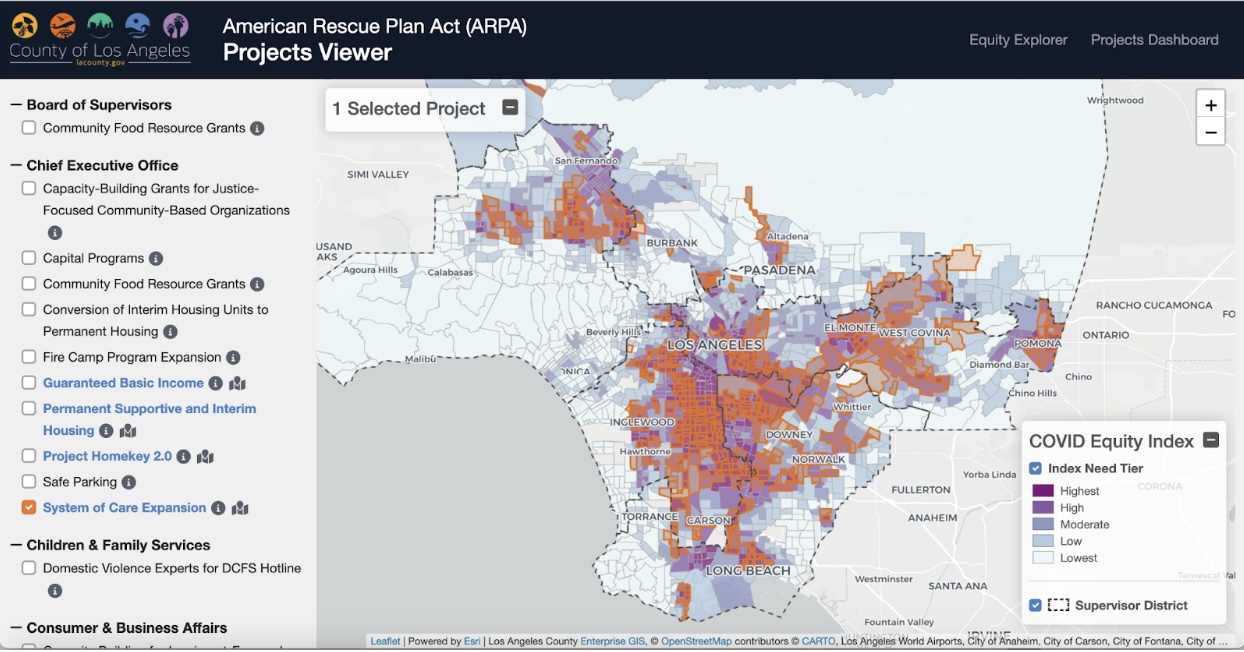Data-Driven Equity Advocacy Steers $1.9 Billion in ARPA Funding
Los Angeles County, CAWhen Los Angeles County was awarded $1.9 billion of federal American Rescue Plan Act (ARPA) funding—the largest county allocation in the country—advocates feared the Board of Supervisors would distribute funds for COVID-19 recovery efforts equally across all county districts. But the Coalition for Equitable ARPA Implementation knew first-hand that the pandemic and economic crisis had not impacted Los Angeles neighborhoods evenly. Neighborhoods experiencing concentrated poverty had nearly three times as many COVID-19 cases than communities with higher incomes, while Black residents, immigrants, and other residents of color disproportionately faced increased housing, food, and economic insecurity. And they acted quickly to advocate for a targeted, equity-driven investment approach.

Composed of the statewide intermediary Catalyst California (formerly Advancement Project California) along with community and labor organizations including InnerCity Struggle, Community Coalition, and SEIU Local 2015, the Coalition for Equitable ARPA Implementation quickly mobilized to ensure ARPA funds reached those most in need. Catalyst California leveraged its COVID-19 Vulnerability and Recovery Index to analyze the impact of COVID-19 by race and class and recommend that the County target funding to the highest-need communities. Armed with this powerful fact base, the coalition advocated that the Board of Supervisors adopt a set of equity principles and an equity funding formula based on its index, and publish a dashboard reporting on expenditures and outcomes. The Board of Supervisors unanimously voted to adopt these recommendations in July 2021. The ARPA coalition then worked with the County’s Anti-Racism, Diversity, and Inclusion (ARDI) Initiative team to share its data and develop equity tools which are now being used by the county to ensure equitable implementation.
Simultaneous to this successful early equity advocacy, the Immigrants Are LA (IRLA) coalition, made up of more than 100 immigrant-serving organizations, launched an advocacy campaign for greater inclusion of immigrants in the County’s ARPA investments and implementation of ARPA-funded programs. This advocacy resulted in about $30 million in important ARPA investments that serve the immigrant community. The coalition also successfully advocated for a motion to establish a working group in partnership with the ARDI initiative, the Office of Immigrant Affairs, and other county departments to ensure immigrant communities can equitably access all county programs.
Centering equity in the decision-making process
Guided by equity principles. Based on the proposals put forth by the ARPA coalition, Los Angeles County developed a set of Countywide Equity Guiding Principles and ARPA Budget Equity Principles to guide its ARPA decision-making. These principles include overarching goals to reduce racial disparities and target resources to the most disadvantaged people and neighborhoods, as well as practices such as authentically engaging communities and ensuring programs and services are culturally and linguistically accessible and available to immigrants and disadvantaged communities. The principles also state that ARPA funds should promote prevention and should “not be used to advance suppression-based efforts via incarceration and policing.”
Summary of Los Angeles County’s Equitable Investment Principles

Led by the County’s anti-racism initiative. The principles were developed by the Anti-Racism Diversity and Inclusion Initiative (ARDI) within the County’s Chief Executive Office in partnership with the Coalition for Equitable ARPA Implementation and other county departments and outside partners. The ARDI Initiative grew out of the County’s adoption of an anti-racist policy agenda in July 2020 that expanded the County’s anti-racist work, which had been focused on justice reform for five years to other arenas of policy impacting Black Angelenos and other historically harmed groups. ARDI now has more than 10 staff and is leading on ensuring equitable implementation of ARPA investments in the County.
Using an equity funding formula based on an index of community need. The County’s equity funding formula was based on Catalyst California’s COVID-19 Vulnerability and Recovery Index, which identifies communities most in need of interventions based on COVID-19 case rates and underlying economic, health, and social vulnerabilities including race/ethnicity. In developing an LA County-specific index, the County engaged with community organizations to add four new indicators to address key equity concerns locally such as immigrant exclusion. After refining the index, the research team examined the extent to which COVID-19 case and death rates correlated with other vulnerabilities and found a strong relationship, justifying targeting resources to the highest-need neighborhoods. Based on this analysis, the county adopted a funding formula that dedicates 40 percent of ARPA funds to the highest-need census tracts, 35 percent to high-need tracts, 20 percent to moderate-need tracts, 3 percent to low-need tracts, and 3 percent to lowest-need tracts.
Supporting county agencies in developing data-driven equitable public investments. The County created an online Equity Explorer Mapping Tool to help county departments and other community members identify and prioritize highest-need communities in project design and implementation. For county agencies, the system allows them to upload additional program-specific data and overlay it on the COVID-19 recovery index. The Commission for Children and Families, for example, overlaid their child protective services data on the index, helping them to better understand multiple community challenges and target community-based supportive services to neighborhoods with the highest needs.
Ensuring projects include impacted but non-geographically concentrated communities. Recognizing that some impacted groups, such as Native American, Pacific Islander, and immigrants, are not in fact geographically concentrated and could be missed by the equity funding formula, the ARPA coalition advocated that the County craft a data and implementation strategy to reach non-geographically concentrated and highly impacted communities (also referred to as “hard to count” communities). The County’s plan includes four key strategies: 1) taking a mixed-methods approach to supplement the quantitative analysis with qualitative information from community members and service providers; 2) using a “public participation geographic information systems” mapping process to engage community members in adding new information to community maps; 3) partnering with community-based organizations and internal county programs that serve hard-to-count populations; and 4) building targeted outreach and engagement strategies into funded programs.
Maintaining a public dashboard tracking equity metrics and project outcomes. Finally, the ARPA coalition called for the adoption of a publicly available dashboard to track how well ARPA spending aligns with the equity funding formula. The County created an ARP Public Portal dashboard that regularly publishes performance data on overall spending and individual projects, including expected goals and outcomes such as the number of residents served and jobs created. The dashboard includes a variety of equity metrics, including spending by community need levels according to the COVID-19 recovery index and the number of members of targeted populations (e.g., people experiencing homelessness, systems-involved people, systems-impacted people) that projects are reaching. The County also publishes a American Rescue Plan Projects Map showing funded projects by department and neighborhood, overlaid with the COVID-19 recovery index.
Los Angeles County’s ARP Public Portal Dashboard Shows Spending by Community Need Levels By Project

Los Angeles County’s ARPA Projects Map Shows Program Reach by Neighborhood

Investing in equity
Together, the equity principles, funding formula, and dashboard have helped the County incorporate an equity-based lens in the selection and tracking of ARPA investments. As a result of the coalition's advocacy, the County committed 75 percent of its first-round ARPA funding to neighborhoods hardest hit by the pandemic.
The County’s ARPA investments aim to set a foundation for a “Better than Before” recovery. As of September 16, 2024, the County had allocated its entire ARPA funding to 115 projects spread across three strategic pillars:
- Equity-focused investments ($971 million) that address the County’s most acute inequities, including creating homes for people experiencing homelessness, implementing the County’s “Care First, Jails Last” alternatives to incarceration initiative, reducing the digital divide, and disrupting intergenerational poverty.
- Building a bridge to equitable recovery investments ($324 million) that provide supportive services to the groups that were most impacted by the pandemic and have the fewest resources, including small businesses, renters, nonprofits, low-wage workers, and food-insecure families.
- Fiscal stability and social safety net investments ($654 million) that continue the county’s public health efforts and strengthen its safety net services.
While the first pillar is explicitly focused on equity investments, the County’s data and principle-driven equity approach carries across all three pillars, and many investments in the second pillar are targeted to the communities and groups most impacted by the pandemic and systemic racism and address underlying structural inequities revealed by the pandemic. Los Angeles County did allocate $214 million in ARPA funds to revenue replacement. These funds were directed toward the County Indigent Aid Budget which provides general relief public assistance payments to low-income residents and is supporting the County’s guaranteed income programs.
The County’s largest area of investment is affordable housing—particularly addressing homelessness in a county where more than 75,000 people go homeless every day, and Black people are highly overrepresented in this extremely vulnerable population (representing 43 percent of the homeless population but just 9 percent of the total population). Housing was also the most commonly cited need among the County’s immigrant-serving organizations.
Some of the County’s key investments that demonstrate promise to advance equity include:
- Housing for people experiencing homelessness and extremely low-income people ($629 million). More than $600 million in ARPA funds are going toward projects that will expand temporary and permanent housing for people experiencing homelessness, including: participating in the statewide Project Homekey program to create 1,000 units of interim and permanent supportive housing by acquiring new hotels, motels, and apartment complexes; converting interim housing units to permanent housing; constructing new housing for homeless people on publicly owned land, providing rental subsidies, ensuring safe parking spaces for vehicle dwellers, and providing intensive case management services and other supports. In addition, the County allocated $80 million to support affordable housing developers in building at least 500 units of housing for extremely low-income people and $40 million to establish a new land bank to facilitate land acquisition for affordable housing for homeless and extremely low-income residents.
- High Road Training Partnerships ($18 million) and Worker Equity Fund ($2 million). Highlighted in our case study, the High Road Training Partnerships workforce development model brings together industries, unions, workers, workforce intermediaries, and training providers to develop strategies that ensure employers have access to the skilled workers they need to be economically competitive and that marginalized workers have equitable opportunities for upward mobility. Through its program, Los Angeles County is working to connect 450 workers to family-sustaining jobs in five high-priority sectors: 1) construction; 2) health care and bioscience; 3) trade and logistics; 4) technology; and 5) early childhood education. The Worker Equity Fund is providing cash assistance to help participants in the training program pay for the transportation, childcare, or other “wraparound supports” they need to successfully complete the program and secure a job placement
- Guaranteed basic income ($42 million) and guaranteed income for at-risk expectant and parenting mothers ($5 million). Through its “Breathe” Guaranteed Basic Income project, the County is providing 1,000 residents with $1,000 payments every month for a three-year period that began in August 2022. One hundred and eighty thousand people applied for the program and participants were randomly selected among applicants who met selection criteria, including living in a lower income household and neighborhood. The Center for Guaranteed Income Research (CGIR) at the University of Pennsylvania is conducting a randomized controlled trial to study the impacts of the program, which was the largest in the country at the time it was announced. The County has expanded the Breathe program with a focus on former and current foster youth. In 2023, the County expanded its program to provide 200 former foster youth with $1,000 per month for two years, and in August 2024, the County announced that 2,000 current foster youth would be provided with a monthly stipend of $500 (or quarterly stipend of $1,500) for an 18-month period. In addition, the Guaranteed Income for At-Risk Expectant and Parenting Mothers program will provide a monthly stipend of $807 for 18 months to a minimum of 400 pregnant residents, targeting groups that experience dire birth outcomes.
- Immigrant-serving programs ($30 million). Despite the County’s efforts to distribute the funds equitably, many of the organizations serving Los Angeles’s immigrant population felt that ARPA funds were not reaching their communities. The Immigrants Are LA (IRLA) coalition worked to advocate for greater immigrant inclusion in the second round of funding allocations and implementation of ARPA-funded programs. IRLA’s advocacy led to important immigrant-serving investments including universal legal representation for all immigrants, capacity building for immigrant-focused CBOs, an equity service navigator program, food assistance for undocumented individuals, and programs to achieve digital equity in the County. IRLA’s advocacy and organizing resulted in the County dedicating more than $163 million to programs that include or focus on immigrants.
Community Advocacy During Second Round of ARPA Allocations Led to Important Investments Serving the County’s Large Immigrant Community
- Trauma Prevention Partnerships ($25 million). Through this program, the County will provide grants to community-based organizations to conduct violence prevention, intervention, and healing strategies, aiming to decrease rates of violence by at least 15 percent in 10 of the 12 communities with the highest rates of violence in the County.
Ensuring equitable implementation
With its spending decisions made, the County has turned toward the challenge of ensuring residents know about available resources and local organizations and small businesses know about contracting opportunities. Advocates are supporting implementation while also assessing the impact of the equity tools put in place to guide ARPA investments and developing recommendations and priorities for further embedding equity throughout county decision-making and investment post-ARPA.
As a part of IRLA’s advocacy, in July 2022, the Board of Supervisors directed county departments to engage immigrant-serving organizations in ensuring their communities can access funding opportunities and demanded that the Office of Immigrant Affairs and ARDI make recommendations on data gathering, standard metrics, reporting, policy, and program changes to ensure immigrant inclusion in ARPA projects.
The County is also collaborating with philanthropy on an Equitable Recovery Initiative to support community-based organizations in applying for ARPA funding, with a specific focus on Black, Indigenous, and people of color-led organizations with budgets under $2.5 million.
Catalyst California has been tracking implementation and is currently wrapping up an analysis of how the County’s myriad departments were able to use the equity tools created for ARPA investments, and what challenges they faced. They found that across the board, contracting with the smaller, community-based organizations most likely to deliver effective services and programs to high-need communities was a challenge, and that working with intermediary organizations that could help smaller organizations meet the legal and regulatory requirements of a federal grant program was a best practice. Operationalizing the equity tools across dozens of departments with varying levels of capacity and buy-in to the equity approach was also a challenge.
Toward transformative change
Community advocates and county leaders both see the equity framework established to guide ARPA fiscal recovery funds as an opportunity to move toward an equity-driven approach to county budgeting. While the ARPA funds were significant, they are just a small fraction of Los Angeles County’s $43 billion overall annual budget, which is larger than the budgets of most states. Taking advantage of the tools built will enable the County to apply the ARPA equity lens to the County’s regular budget and operations—an essential step forward if the County is to achieve the five goals for population-level change laid out in the 10-year Racial Equity Strategic Plan.
ARPA has been an important testing ground for the County’s equity framework, with the potential to leave an enduring imprint. According to Dr. Scorza, ARDI is currently exploring strategies to extend successful elements of the ARPA process to its ongoing operations, including program design, data collection, and evaluation.
As this case study demonstrates, equitable resource allocation requires community engagement throughout the process—even with a robust government equity framework in place. This means that community organizations must be resourced to have the time to engage, as well as the tools and know-how to do so effectively. Masih Fouladi, Executive Director of the California Immigrant Policy Center and former Co-Chair of the Immigrants are LA (IRLA) coalition as part of the Council on American-Islamic Relations-LA, describes how IRLA’s ARPA campaign goals were trifold: secure investments in the County’s immigrant communities; make the design and implementation of county programs more inclusive; and build the capacity and power of immigrant-serving organizations. “What we really tried to do with ARPA is build the infrastructure to set the immigrant community up to be able to be involved in budget advocacy in the future,” Fouladi says. The coalition’s successful budget advocacy efforts this past year indicate that they’ve built their own capacity to steer the county budget toward immigrant inclusion.
Several local and statewide funders banded together to support the coalition’s work, and continued philanthropic investment in community capacity will be necessary to ensure that Los Angeles County’s future budgets support its goals of greater equity and inclusion.
While it is too soon to know the ultimate equity outcomes of the County’s bold and innovative approach to ARPA, or exactly how this pandemic program will translate into the regular process of decision-making, the processes of institutional change and community capacity-building are clearly underway in the country’s most populous county.
